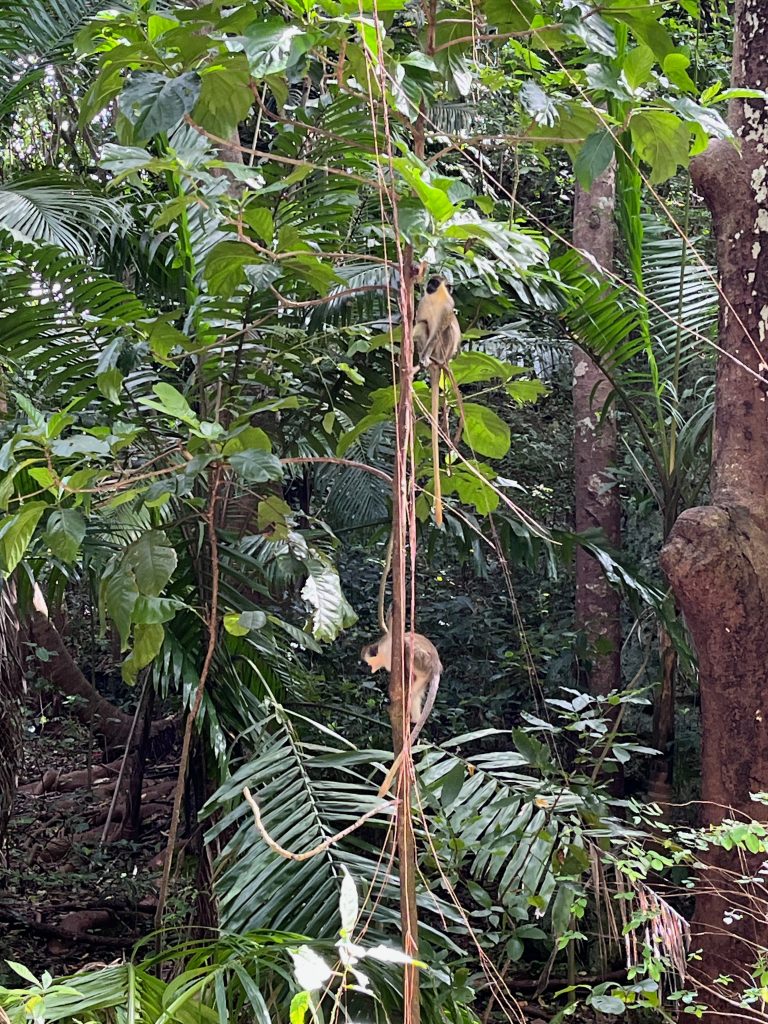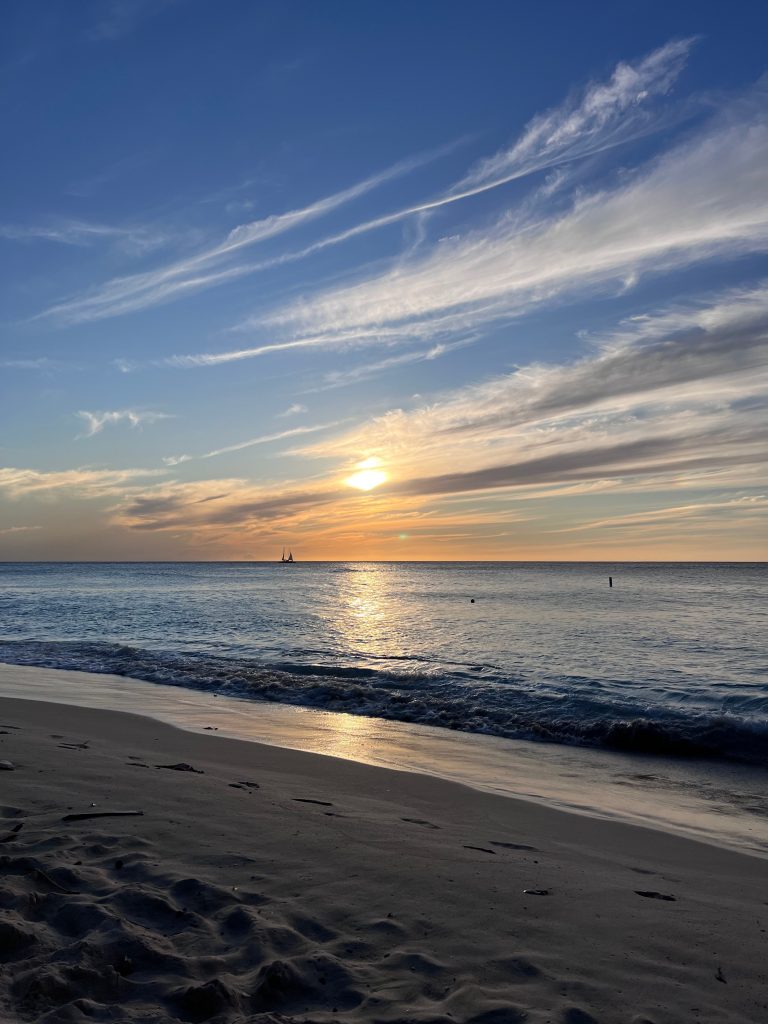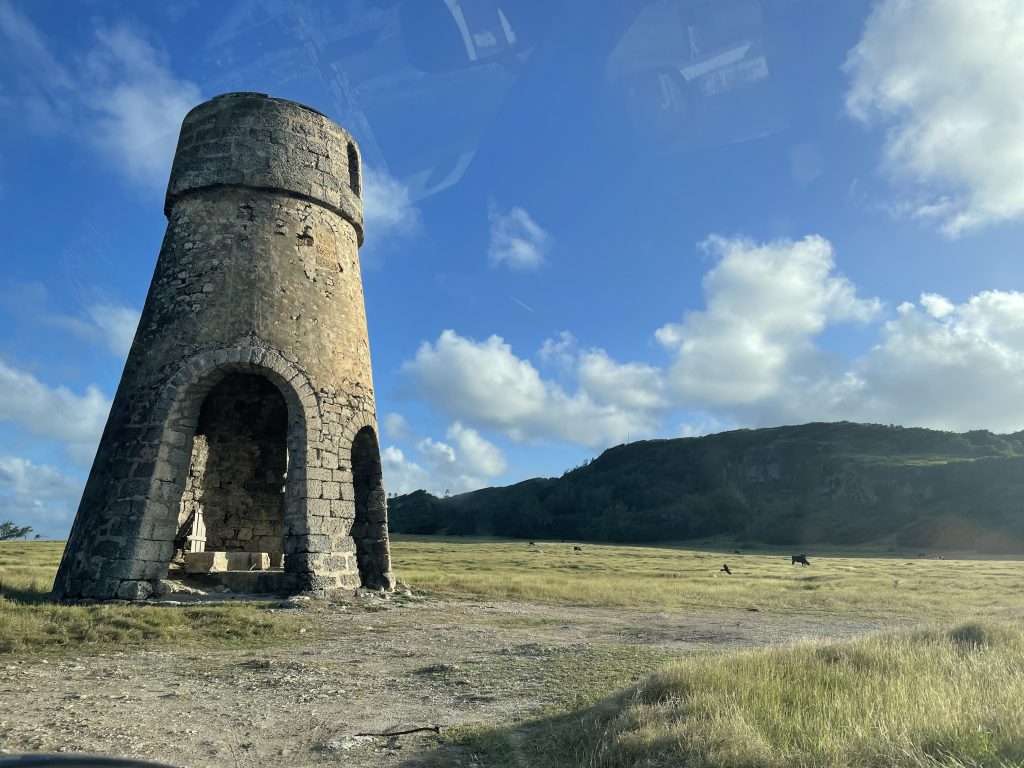I’m a big fan of swimming outdoors. I love lidos, lakes, rivers, the ponds at Hampstead Heath and Beckenham, the tidal pool at Margate’s Walpole Bay. But the sea in Barbados is my original swim. I learned there as a child, living in Prospect, St. James when I was aged four to six. If you have swum in tranquil Caribbean seas, then you’ll know it’s like swimming in liquid azure and turquoise silk. The water welcomes you, ushers you in. The sand is cushiony, its colour the soft, washed-out pink of finely crushed coral. It’s not perfect; like any sea, there are things in there that will scrape and sting you. But, if I had to be stung or scraped in any sea, make it Caribbean.
I also love swimming in Barbados’ less welcoming beaches and sitting in the rockpools at Bathsheba, getting rolled in the surf at the Crane. What my many swims on a recent trip reminded me is that I know exactly how to be in the sea. I know how to float on the surface (clenching your bum cheeks is key) and listen to the shimmering sound of seawater stirring up sand. I know to stand sideways in the face of a daunting wave or, if it’s really big, go under it to emerge through it. I know how to catch the tide with no board, just my body, and let it sweep me into shore. I have muscle memory for the sea.
“The sand is cushiony, its colour the soft, washed-out pink of finely crushed coral”
Before I set off on this trip, my first since 2017, I worried I’d feel a sense of cultural dislocation while there; a hyperawareness of my Britishness after several years away. Instead, where I expected severance, I felt connected. The trip reminded my sister and I of our Bajanness, leading to moments of joy in self-recognition. For her, it was the sun-soaked chattel house colours that crop up in her design work. For me, it was my taste for intense flavours and sweetness in foods like Bajan curry or sugar cakes. And, for both of us, its rhythms – the sound of tree frogs after 6pm, the insect-like buzz of wind-winnowed kite strings, the cu-coo-cu-coo of Bajan wood doves.
Barbados is often presented as a place of two halves. There’s its Platinum coast, the foundation on which the country’s tourism industry rests, home to the kind of beaches that you might mistake for screensavers. But there’s much more to the west coast than its beauty. Resorts and private villas rub shoulders along much of it, yet you can still see the modest homes of local Bajans every now and then. And, no matter how exclusive a resort may seem, the beaches they’re built on are public – in theory. In practice, thanks to overdevelopment of the coastline, this freedom is under threat. During the trip, I saw how stretches of shoreline had become segmented and impassable in places, as coastal erosion brings the water right up to the walls of private beachfront properties. It’s a reminder of how colonialism not only echoes down centuries, but evolves.


Then there’s the east coast. Here waves don’t lap but smack, pounding shores and rock faces with a rage intensified across thousands of miles of open ocean. There are rockpools, towering remnants of ancient coral reefs, wind-battered palm trees. As you might expect, it’s home to far fewer resorts. Both east and west coastlines are natural wonders with hidden depths, but they’re so often reduced to their user-friendliness – the one where it’s easy to swim and the one where it isn’t. Sometimes, when hearing or reading about Barbados, you could be forgiven for thinking it is nothing but a giant sandbar made of two coastlines zipped up back to back, despite the fact there’s a whole south coast too.
As I explored the island in a tiny hire car with my boyfriend, rumbling over potholes and braking for troops of monkeys, I was reminded of how overly simplistic this idea of Barbados is. There is so much that exists in between the island’s coasts. There are gullies full of the bearded fig trees that inspired the island’s name. There are the rum shops in which gassin’ is elevated to a fine art and where I came to understand my grandfather’s love of talking a lot about not very much. Then there’s the plantation houses and sugar mills – the scars that bear witness to the history of colonialism and enslavement on the island.

There was something in the oversimplification of Barbados, in the way it’s put into neat packages for a certain audience, that really resonated with me. I’m mixed race, so being carved up into chunks comes with the territory. Parcelling myself up neatly is something I’ve consciously been trying to do less of lately. But in Barbados I realised I also place binaries on myself in so many other ways. I’m always sorting myself into good – when I’m productive, tidy, organised, energetic – and bad – when I’m tired for no reason, can’t be bothered, running late, eating three Terry’s Chocolate Oranges in a week.
I’ve also done this on a grander level, with the self I felt I left in Barbados when I moved back to the UK aged six. As a frequently sad, socially awkward, shy, self-conscious adult, I looked back on my Barbados self with wonder and envy. I wished I had her confidence, her ability to make instant friends, her carefree nature and, yes, her multi-coloured foam sandals. The fact that my parents split up when we lived in Barbados only emphasised the gap between the two me’s in my mind. Shortly after their split, my sister and I returned to the UK with our mum, and my dad stayed in Barbados. Needless to say, under-six me hadn’t known sadness like it.
“There was something in the oversimplification of Barbados, in the way it’s put into neat packages for a certain audience, that really resonated with me”
Leaving Barbados represented the loss of so many things – one of them that sunny younger self. But feeling that muscle memory in the water, remembering those sea skills I’d learned in Barbados as a small child, reminded me that she’s still in there. Even though life’s brutal lessons – grief, sadness, mental health struggles – have humbled me, I still have that strength. Only now, I channel it differently. I saw this reflected in Barbados too. Coastlines are shifting and hotels are built, knocked down and rebuilt endlessly. Barbados now has fields full of solar panels and there’s a new Chefette mega playground, but it is still Barbados. In the same way, in the wake of both gentle and devastating waves, I too shift and evolve. But I’m still me.
Barbados is not two coastlines put back to back. It’s not half beautiful beaches, half rugged shoreline. It’s a patchwork, rich and wonderful precisely because of its contrasts. And it’s the same for me. I’m not good or bad, half this or half that. I’m not rupture, I’m not disjointed scraps, I have sewn myself back together many times. I’m Bajan, I’m British, I’m mixed, I’m a whole me.
Highlights
- All Barbados beaches are public, look out for signposted access points along the coast roads.
- Grab a table by the sea for lunch or late afternoon drinks at beach bar La Cabane, you can spot turtles popping their heads up out of the surf.
- Head up to the northernmost point of the island at the Animal Flower Cave for wild (in both senses of the word) scenery. Go inside the caves for a fee or head to the clifftop viewpoints to see mighty ocean waves crashing into coral rock faces for free.
- If you have even the vaguest interest in plants, you must visit at least one of the island’s gardens. Andromeda Botanic Gardens is full of hummingbirds, butterflies and hundreds of different tropical plants.It’s free for Royal Horticultural Society members. Welchman Hall Gully offers a shady forest walk and a snapshot of Barbados’ botanical history. Tropical Gardens is the place to see orchids in all their weird and wonderful glory. The Flower Forest gives you the best of both tropical flowers and trees, and Hunte’s Gardens is a peaceful plant-filled spot whose owner Anthony is always up for a chat.
- Chefette! Fun fact: there are no McDonald’s in Barbados. Why? Because Chefette exists. Fill up on broasted chicken and rotis while you can because this homegrown fast food chain is only found on the island.
- Catamaran cruises aren’t cheap but they’re worth it. You can snorkel over shipwrecks, spot turtles and starfish and cruise along the coast with unlimited rum punch on tap. Give Cool Runnings a try.
- Barbados is home to some incredibly talented potters and ceramic artists. There’s the legendary Earthworks, with its signature splashes of colour, but be sure to check out Hamilton’s Pottery for experimental pieces (he’s recently been working with ash from the 2021 explosion of nearby St Vincent’s La Soufrière volcano) and Highland Pottery for striking vases, mugs and traditional Bajan monkey pots (used to cool water).
Useful information
- Exploring Barbados is easiest by hire car but the busy bus network is also a brilliant way to get around. There’s the blue government buses which are your more typical bus experience. Then there’s the yellow dub buses, which can be hailed pretty much anywhere along the road, screech along at breakneck speed and feature sound systems that ensure they’re often heard before they’re seen. It’s an experience worth having at least once.
- Speightstown is a great place to stay if your budget doesn’t stretch to car hire for any or all of your trip. It’s relatively quiet, easy to travel to and from by bus and you’ll be within walking distance of the supermarket, restaurants, beach bars and shops. Plus Speightstown beaches have some of the clearest water on the west coast.
- You can buy fresh coconut water as well as mangoes and avocados (depending on the season) from roadside stalls. It’s a great way to stock up on fresh fruit on the go.
- It used to be that Barbados’ dry season ran from December to April and, while this is largely still the case, the climate crisis is blurring these kinds of distinctions. Other times of year tend to be rainier, but luckily this isn’t British drizzle, we’re talking dramatic tropical thunderstorms that generally arrive and depart rapidly, so don’t be dissuaded.
The contribution of our members is crucial. Their support enables us to be proudly independent, challenge the whitewashed media landscape and most importantly, platform the work of marginalised communities. To continue this mission, we need to grow gal-dem to 6,000 members – and we can only do this with your support.
As a member you will enjoy exclusive access to our gal-dem Discord channel and Culture Club, live chats with our editors, skill shares, discounts, events, newsletters and more! Support our community and become a member today from as little as £4.99 a month.

